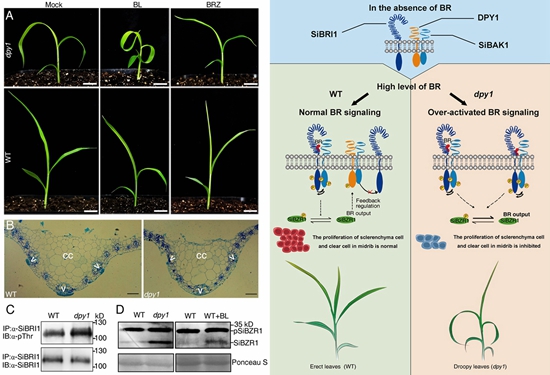Chinese Scientists Identify DPY1 as a Brake System of Brassinosteroid Signaling to Modulate Leaf Droopiness
Recently, researchers from the Institute of Crop Sciences, Chinese Academy of Agricultural Sciences, together with their collaborators revealed that a new gene, DROOPY LEAF1 (DPY1), can prevent over-activation of Brassinosteroid (BR) signaling in response to high doses of BRs, which in turn ensures that leaf growth is upward in Setaria. This study provides a new insight into plant architecture regulation for cereal breeding. Related paper entitled DROOPY LEAF1 Controls Leaf Architecture by Orchestrating Early Brassinosteroid Signaling was published in PNAS on August 18, 2020
(https://doi.org/10.1073/pnas.2002278117).
“The leaf is the primary organ for the capture of light and organic compound synthesis in plants. For cereal crops, leaf architecture is an important agronomic trait that directly determines canopy structure as well as grain yield. Many cereal plants have long narrow leaves. The leaf angle, arc from the leaf midrib to the stem, and blade strength are the primary determinants of leaf architecture”, wrote Professor Xianmin Diao, the corresponding author of the paper. “BRs are well known to control the leaf angle by regulating cell expansion and division, while the molecular mechanism underlying blade strength regulation is still unclear, which hinders further plant architecture improvement”.
Researchers isolated DROOPY LEAF1 (DPY1) from an ethyl methanesulfonate (EMS) mutant. They found that DPY1 interacted with and competed for SiBAK1 and as a result, it caused a sequential reduction in SiBRI1/SiBAK1 interaction, SiBRI1 phosphorylation, and downstream BR signaling in Setaria. Conversely, DPY1 accumulation and affinity of the DPY1/SiBAK1 interaction are enhanced under BR treatment, thus preventing SiBRI1 from over-activation. In summary, the findings indicate a negative feedback mechanism that represses leaf droopiness by preventing an over-activation of early BR signaling in response to excess BRs.
The researchers also found that DPY1 promotes division of clear cells and abaxial sclerenchyma cells in the leaf midrib to ensure that leaf can grow upward. The molecular mechanism of DPY1 in leaf architecture regulation is conserved among the Panicoideae subfamily.
Due to its small genome size, high transformation efficiency and short life cycles, foxtail millet and its ancestor S.viridis are developed as a model system especially for the research on C4 photosynthesis and plant functional genomics. This study will promote Setaria as a new model.

Figure. Proposed model for the DPY1-mediated control of leaf architecture
By Jia Guanqing (jiaguanqing@caas.cn)
-
 Apr 18, 2024Opening Ceremony of the Training Workshop on Wheat Head Scab Resistance Breeding and Pest Control in Africa Held in CAAS
Apr 18, 2024Opening Ceremony of the Training Workshop on Wheat Head Scab Resistance Breeding and Pest Control in Africa Held in CAAS -
 Apr 03, 2024IPPCAAS Co-organized the Training Workshop on Management and Application of Biopesticides in Nepal
Apr 03, 2024IPPCAAS Co-organized the Training Workshop on Management and Application of Biopesticides in Nepal -
 Mar 28, 2024Delegation from the School of Agriculture and Food Science of University College Dublin, Ireland Visit to IAS, CAAS
Mar 28, 2024Delegation from the School of Agriculture and Food Science of University College Dublin, Ireland Visit to IAS, CAAS -
 Mar 25, 2024Director of World Food Prize Foundation visited GSCAAS
Mar 25, 2024Director of World Food Prize Foundation visited GSCAAS -
 Mar 20, 2024Institute of Crop Sciences (ICS) and Syngenta Group Global Seeds Advance Collaborative Research in the Seed Industry
Mar 20, 2024Institute of Crop Sciences (ICS) and Syngenta Group Global Seeds Advance Collaborative Research in the Seed Industry
